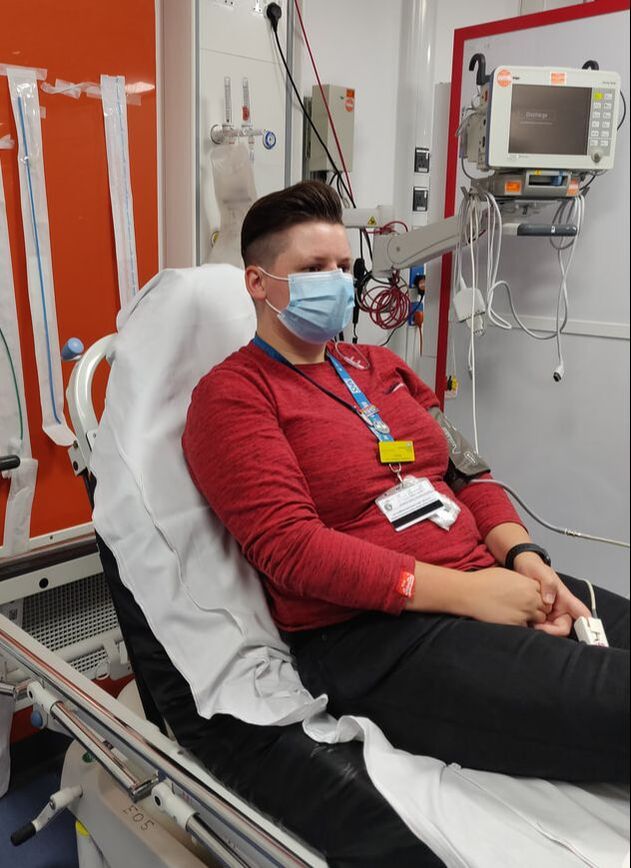|
For October the sim theme is “breathing”. This blog covers some of the learning points from 08/10/20. We will be aiming to run simulations weekly - mostly Fridays but not always - see the gmail calendar. We previous ran a simulation a few weeks ago of a paediatric asthma case - see the blog post - and this week have reviewed asthma in an adult case. The simulated case: Laura is in her 20s and has presented short of breath. She has previously been admitted to ICU as a result of her asthma. What key questions are important here to work out the cause of breathlessness?
What did we think? In debrief we discussed: Choice of oxygen delivery: with sats almost normal could apply low flow, or initiate 15L/min non-rebreathe and titrate down with assessment. We talked about identification of whether Laura should be considered a possible COVID19 case, which could have implications for safety of those treating her and geographically where in the department she should be looked after in. The Pubic Health England case definition as of 28/09/20 is “new continuous cough or temperature ≥37.8°C or loss of, or change in, normal sense of smell (anosmia) or taste (ageusia)” (Public Health England 2020) however I will find out exactly which criteria we are working from in the Emergency Department and update this paragraph with that information shortly. [EDIT 14/10/20]: the criteria for moving to Plym ED as of 19/06/20 are: fever PLUS acute-onset respiratory symptoms (persistent cough, hoarseness, nasal congestion/discharge, shortness of breath, sore throat, wheezing, sneezing) OR clinical/radiological pneumonia OR anosmia. The patient in this sim had respiratory symptoms so no fever, so unless pneumonia was clinically expected/radiological found, they were appropriate to be outside of Plym. [end of edit]. We discussed the dose of salbutamol nebuliser. Anecdotally I have been told 5mg produces no additional benefit over 2.5mg with greater risk of side effects, although I admit I haven’t seen the evidence of this. A BestBET specific to COPD reviewed one double-blind RCT and found no difference in outcome between 2.5mg and 5mg (Kusre 2010) - note albuterol is the US name for salbutamol. Please do comment below if you have further experience or information about this choice. We talked through analysis of blood gas results for this patient. In particular the importance of noting pCO2 in an asthma exacerbation. We expect it to be lower than normal range. So if in the normal range on an arterial sample this is a worrying sign of impending exhaustion and failure - escalate these patients urgently. Note on the BTS/SIGN guideline, a normal pCO2 of 4.6–6.0 kPa is considered a sign of life-threatening exacerbation, and a raised pCO2 considered near-fatal. We discussed whether d-dimer would be tested in this scenario. We know that in d-dimer testing it is important to consider both the test characteristics, and the pre-test probability of PE. D-dimer has a good sensitivity for PE, but a specificity of around 41% (Perrier et al 1997), meaning that of people without PE, many will still have a positive test. So we need to consider the patient’s pre-test likelihood of PE, such as with Well’s scoring, to decide how a positive or negative test is going to influence that probability before we test it. In practice it may be that blood is being taken before this assessment has taken place, so if we are already performing coagulation tests on the “blue tube” we can consider after our assessment whether to add-on d-dimer or not. We noted in the scenario several times that communication techniques were used to good effect. In an SBAR handover, a key point of a pause followed by “I am concerned because X” with eye contact grabbed the attention of the listener to vital information. Between colleagues use of “are you happy with doing X while I do Y?” summarised tasks that needed to be done whilst ensuring the other person was trained and able to carry out that task, and allowed them the opportunity to “close the loop” in their response. Feedback from the participants noted that it can be difficult to find peak flow meters, and that it would be helpful to have had greater nursing staffing both in terms of caring for patients like this, but also in being able to attend simulation training. The guidelines: Our EDIS guideline on adult acute asthma is the same as page 17-18 of the BTS/SIGN quick reference guide. This gives an overview or both assessment and treatment. It was used in the scenario to categorise the attack as “acute severe” and not yet in the “life-threatening” or “near-fatal” categories. Choice of steroid: the BTS/SIGN guidelines 2019 (page 102) state: “steroid tablets are as effective as injected steroids, provided they can be swallowed and retained. Prednisolone 40–50 mg daily or parenteral hydrocortisone 400 mg daily (100 mg six hourly) are as effective as higher doses.” BTS/SIGN 2019. To do:
Review the quick overview guideline, which is via “ED browser” on EDIS, or page 17-18 here [ ] Reflect on how scary it would be to be admitted with an asthma attack such as this, and how we might consider helping this anxiety in patients we see [ ] If you need to, consider reading an overview of blood gas interpretation - there are many online, for example this one by Geeky Medics [ ] If you took part in the sim, you can use this blog as a starter to reflect on your own experience of it [ ] James Keitley - ED simulation fellow --------------- For clinical decisions please refer directly to the guidance. This blog may not be updated.
0 Comments
Leave a Reply. |
Categories
All
The Derrifoam BlogWelcome to the Derrifoam blog - interesting pictures, numbers, pitfalls and learning points from the last few weeks. Qualityish CPD made quick and easy..... Archives
October 2022
|

